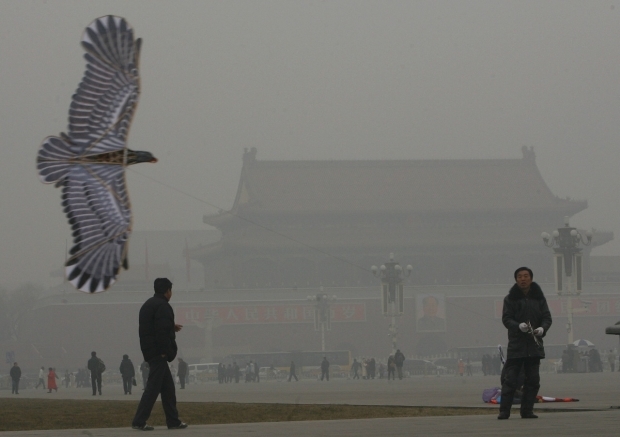China is now the world’s biggest emitter of greenhouse gases, and so the world will pay close attention to its stance at next year’s climate negotiations in Paris, as well as to the kinds of actions it takes to tackle climate change post-2020.
Despite the fact that China has published a report setting out its policies and actions for addressing climate change every year since 2008, the international community still appears to harbor doubts about its resolve to seek an international deal. But actively tackling climate change is fundamental to sustainable development in China, and this will drive its leaders to push even harder for a new deal next year.
It isn’t hard to see that China’s motivation is genuine. First, China is suffering badly from the adverse effects of climate change. Over the last hundred years, the annual average rise in temperatures in China has been higher than the global average. Climate change causes uneven distribution of rainfall and water resources, both temporally and spatially, and intensifies damage from extreme weather events.
Since the 1990s, China has suffered annual average economic losses of over 200 billion yuan (U.S.$32 billion) as a direct result of extreme weather events, and an annual average death toll above 2,000. Climate change continues to impact living conditions—and the ability to achieve sustainable development—in many regions.
The latest reports from the Intergovernmental Panel on Climate Change (IPCC) predict that rising temperatures will grow more pronounced, adverse impacts will intensify, and damage from extreme weather events in China will get even more serious. To pursue benefits and minimize harm, China must mitigate the adverse effects of climate change if it wants to achieve sustainable development.
Second, there is no contradiction between the direction of China’s economic development and tackling climate change.
China’s most obvious achievement over the past 30 years has been its rapid economic rise, but the majority of its industries are located at the bottom of the supply chain. Home-grown innovation has been weak and key technologies lacking, while China has struggled with an excess of low-end production capacity.
Now, however, China has started to establish innovation-based development. It is adjusting its economic structure, and no longer pursuing development at the cost of the environment. This new development path means that China has to lower its total energy consumption and change its energy framework to support further adjustments to its economic structure.
Third, the need to deal with smog is strengthening the resolve to tackle climate change.
Smog and greenhouse-gas emissions actually come from the same sources. The government has resolved to tackle air pollution by closing down heavily polluting and energy-intensive industries, restricting coal consumption, developing and using clean energy and limiting vehicle use. These measures also directly help reduce greenhouse-gas emissions, creating synergies to address climate change.
Fourth, tackling climate change and building China’s hoped-for “ecological civilization” are one and the same.
Building an ecological civilization (a concept first advanced by former president Hu Jintao) is the only choice China has if it is to break away from resource restrictions, environmental degradation, and pollution—and it has a lot of public support. This ecological civilization requires encouraging people to respect, adapt to, and protect nature, to focus on green and low-carbon development, and advancing the circular economy; and creating favorable environments for production and economic development and a safe environment for people to live in.
We must reform our ways of production, our lifestyles, our system of values, and our institutions, and innovate within these spheres. These goals are identical to those of tackling climate change.
Negotiating a Deal that Fosters Innovation
Signatories to the United Nations Framework Convention on Climate Change (UNFCCC) are now negotiating a new climate deal. With the deadline for the new agreement (the end of 2015) looming, talks have reached a critical stage. Each country is engaged in deep discussions over the principles, structure, key elements, timelines, and the legality of the deal.
Taking into account the positions of all the different parties to date, the new agreement must ultimately conform to one of three models—top-down, bottom-up, or a combination of the two. For negotiation, and implementation, each of these has its advantages and deficiencies. The final deal must look at the whole world, but take into account the conditions of each country. We can only solve climate change when each nation adopts a model that fits its own circumstances as quickly as possible.
Every year for the past few years, China has published its existing and imminent climate-change measures and actions, and the country has made an enormous effort to honor its 2020 climate-change targets (China is committed to a 40-45 percent reduction in carbon intensity on 2005 levels by 2020). Last year’s agreement at the climate change conference in Warsaw requires all countries to publish their “intended nationally determined contributions” by the first quarter of 2015. China has accelerated the completion of its own goals, and will come up with even more ambitious climate-change measures by the deadline. It is also actively promoting the catalytic effect of innovation in technology and systems in the new agreement.
Meanwhile, the new deal can be used as an opportunity to improve energy conservation and emissions reduction and to promote a whole series of institutional innovations to tackle climate change and motivate society to take part, including advancement of low-carbon technologies, better collection of emissions data, low-carbon trials, and emissions trading.
Whether these measures are aimed at mitigating climate change, or adapting to its impacts, they all rely on technological and institutional innovations.
In short, China's economic and social development has reached a historical turning point where it must restructure its economy. Underlying demand will inevitably drive China to use increasingly aggressive measures and actions to address climate change. This is an irreversible process, and it will determine China's future.




